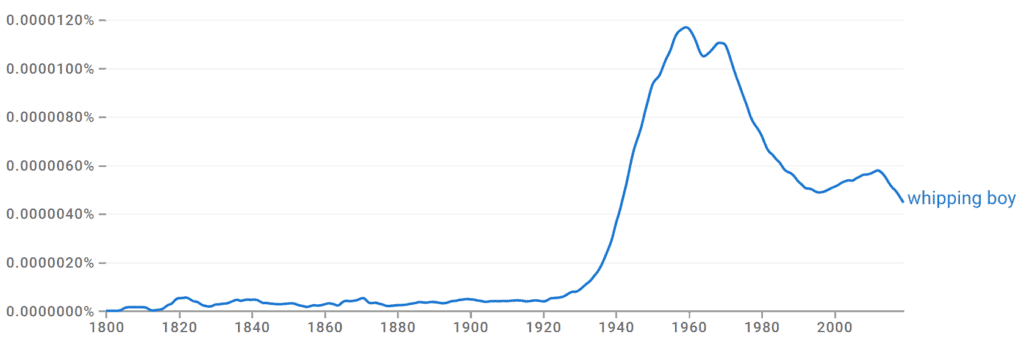Many terms and phrases in the English language are influenced by various historical events and societal practices from years past. They have often made their way into modern usage without people having a complete understanding of their origins or meanings.
A whipping boy is an excellent example of this. Commonly used to label a person being blamed for something they didn’t do, the term has a long and illustrious history. Let’s learn about it here.
What Is the Meaning of a Whipping Boy?

In a modern context, a whipping boy is a person who is blamed or punished for the failings or actions of others. Another way to explain this unfair label is to compare a whipping boy to a fall guy or as a scapegoat.
For example:
- The company used the economy as its whipping boy to the public when explaining the rising prices. However, they simply could not budget inventory with consumer demand and almost always had wasted surplus.
- Politicians often like to go after their political opponents to use them as whipping boys rather than address the measurable causes of economic issues.
- The baseball team had a promising start but ended on a disappointing note, with the franchise using the coaching as a whipping boy, when in fact, the real fault fell on the shoulders of the over-pain and under-talented pitcher.
Whipping Boy Origins

Whipping boy was an official position in the English royal court during the fifteenth and sixteenth centuries. A high-born boy was chosen to be the companion to a royal prince and was educated alongside him, receiving many of the privileges of royalty. However, if the prince committed a transgression, the whipping boy was punished in his stead.
The philosophy was that if a prince saw his friend punished, he would suffer greatly and be sure to behave. A commoner, such as a tutor, could not lay a hand on a royal prince, and the use of a whipping boy solved this problem.
The first documentation of whipping boy in its literal context is from the 17th century in John Trapp’s writings “A commentary or exposition upon the five books of Moses”:
- “Rebuke before all: yet not as if they were whipping boyes.”
It is again used to specifically reference the whipping boy of the young King Charles I, William Murry, the nephew to the prince’s tutor. This occurrence was recorded in 1715 by Gilbert Burnet in “History of His Own Time“:
“William Murray of the bed-chamber, that had been whipping boy to King Charles the first.”
The term whipping boy isn’t used as an allusion until much later, with the first known use seen in “The Times” in 1857:
“Or will the public still have reason to say that M. Migdeon, even supposing all that has been brought against him true, is merely the whipping boy?”
By then, the use of the term in a figurative sense had caught on and was made even more popular in Mark Twain’s publication “The Prince and Pauper” in 1881 in Canada and 1882 in America:
“Of a surety thou must remember me, my lord. I am thy whipping-boy.”
Let’s Review
Despite its very literal inception that offered the punishment of a prince to a boy in his stead, whipping boy is now used in a figurative sense to put the blame on the shoulders of an innocent party.
This modern-day usage became popular in the 19th century, especially after being used in Twain’s popular story “The Prince and the Pauper,” which used the literal definition as an analogy within the plot itself.
Here are some idioms we covered:
